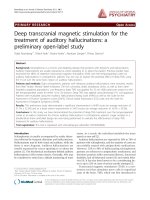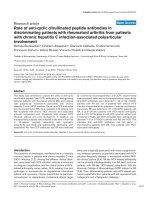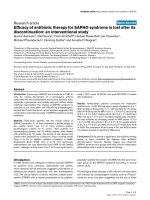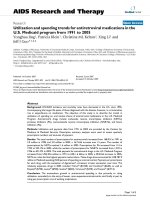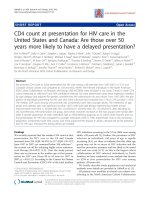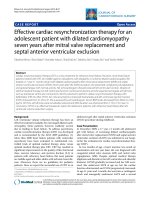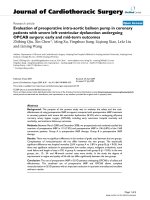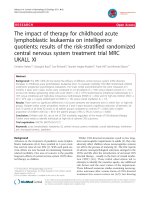Báo cáo y học: " CHAMP: Cognitive behaviour therapy for health anxiety in medical patients, a randomised controlled trial" pdf
Bạn đang xem bản rút gọn của tài liệu. Xem và tải ngay bản đầy đủ của tài liệu tại đây (216.9 KB, 7 trang )
STUDY PROT O C O L Open Access
CHAMP: Cognitive behaviour therapy for health
anxiety in medical patients, a randomised
controlled trial
Peter Tyrer
1*
, Sylvia Cooper
1
, Helen Tyrer
1
, Paul Salkovskis
2
, Mike Crawford
1
, John Green
3
, Georgina Smith
3
,
Steven Reid
3
, Simon Dupont
4
, David Murphy
5
, Sarah Byford
6
, Duolao Wang
7
and Barbara Barrett
6
Abstract
Background: Abnormal health anxiety, also called hypochondriasis, has been successfully treated by cognitive
behaviour therapy (CBT) in pat ients recruited from primary care, but only on e pilot trial has been carried out
among those attending secondary medical clinics where health anxiety is likely to be more common and have a
greater impact on services. The CHAMP study extends this work to examine both the clinical and cost effectiveness
of CBT in this population.
Method/Design: The stud y is a randomized controlled trial with two parallel arms and equal randomization of 466
eligible patients (assuming a 20% drop-out) to an active treatment group of 5-10 sessions of cognitive behaviour
therapy and to a control group. The aim at baseline, after completion of all assessments but before randomization,
was to give a standard simple explanation of the nature of health anxiety for all participants. Subsequently the
control group was to receive whatever care might usually be available in the clinics, which is normally a
combination of clinical assessment, appropriate tests and reassurance. Those allocated to the active treatment
group were planned to receive between 5 and 10 sessions of an adapted form of cognitive behaviour therapy
based on the Salkovskis/Warwick model, in which a set of treatment strategies are chosen aimed at helping
patients understand the factors that drive and maintain health anxiety. The therapy was planned to be given by
graduate research workers, nurses or other health professionals trained for this intervention whom would also have
their competence assessed independently during the course of treatment. The primary outcome is reduction in
health anxiety symptoms after one year and the main secondary outcome is the cost of care after two years.
Discussion: This represents the first trial of adapted cognitive behaviour therapy in health anxiety that is large
enough to test not only the clinical benefits of treatment but also whether the cost of treatment is offset by
savings from reduced use of other health services in comparison to the control group.
Cognitive behaviour therapy for Health Anxiety in Medical Patients (CHAMP)
Trial registration: Current Controlled Trials ISRCTN14565822
Background
Abnormal health anxiety - and its older synonym, hypo-
chondriasis - is a relatively common p roblem in both
primary and secondary medical care settings [1-3]. It
also places a substa ntial burden on he alth services [4],
as its central feature is sufficient fear of having a serious
disease to lead to medical consultation, and, very com-
monly, this is followed by further investigations. This
condition, despite its ubiquity and its ability to provoke
considerable suffering, is often unrecognised or appre-
ciated at a superficial level. Even when the condition is
recognised, concerns over litigation may lead t o expen-
sive investigations being carried out unnecessarily. This
may provoke further pathology when findings of mar-
ginal clinical significance are reported. The extra burden
on services is particularly important in secondary
* Correspondence:
1
Centre for Mental Health, Imperial College, Claybrook Road London, W6
8LN, UK
Full list of author information is available at the end of the article
Tyrer et al. BMC Psychiatry 2011, 11:99
/>© 2011 Tyrer et al; licensee BioMed Central Ltd. This is an Open Access article di stributed under the terms of the Creative Commons
Attribution License ( .0), which permits unrestricted use, distribution, and reproduction in
any medium, provided the original work is properly cited.
medical care. Between 10 and 20% of all attenders at
medical clinics have abnormal health anxiety [5-7] and
patients often rotate between different clinics depending
on the focus of their symptoms. The symptoms of
abnormal health anxiety show little tendency to sponta-
neous resolution and persist fo r months in th e absence
of treatment [5].
The failure to detect this serious pathology is perhaps
less surprising when there is a general belief that there is
no adequate treatment. Pharmacologi cal management is
generally unsatisfactory but psychological treatment in
the form of cognitive behaviour therapy (CBT) has been
shown to be effective, mainly in primary care [8,9] and,
more recently, in a secondary care medical clinic [10].
Although these trials suggest efficacy of this intervention,
it is less clear if it has a significant impact on costs.
Although the total costs were somewhat reduced in those
receiving cognitive behaviour therapy in the only trial in
secondary care, these only became manifest in the six
months after treatment had been completed [10]. The
CHAMP trial is the natural successor to these studies,
and examines both efficacy and cost-effectiveness of this
newly modified treatment over a two-year period.
Research objectives
The main objective s of the CHAMP trial are to examine
the clinical value, cost and cost-effectiveness of the
administration of CBT in health anxious patients attend-
ing out-patient clinics in secondary care. Specifically we
hypothesised that (i) between 5 and 10 sessions of
health anxiety directed cognitive behaviour the rapy
using the Salkovskis/Warwick model [11,12] would be
more effective than normal care in the clinic in reducing
abnormal health anxiety recorded by changes in the
Health Anxiety Inventory (HAI)[13] one year af ter ran-
domisation to the trial, and (ii) the cost of the CBT and
control are equivalent, the endpoint for this outcome is
the cost of health service interventions at 2 years
adjusted for baseline values.
The secondary hypotheses are that, compared with the
control condition, health anxiety directed cognitive
behaviour therapy will lead to significantly greater
improvement in health anxiety at 3, 6 and 24 months
measured using the Health Anxiety Inventory (HAI)[13],
in self-rated generalized anxiety measured using the
Anxiety section of the Hospital Anxiety and Depression
Rating Scale (HADS-A)[14], in quality of life using the
EQ-5D measure of health-related quality of life [15], and
in social functioning using the Social Functioning Ques-
tionnaire (SFQ)[16], all at 6, 12 and 24 months, result in
thelossofthediagnosisofhypochondriasisat24
months using the criteria of the Structured Clinical
Interview for DSM-IV [17] and will be a cost-effective
use of reso urces, where improvements in outcomes
(measured using the HAI and in QALYs) are considered
worthwhile.
In addition we will test the hypotheses that health
anxiety focused cognitive behaviour therapy will be less
effective in patients who have additional comorbid
pathology in the form of (i) obsessional symptomatology
(using the Short Obsessive Compulsive Screening
(SOCS)[18]), dependent personality (using the Depen-
dent Personality Questionnaire [19]), and hypochondri a-
cal and other personality disorders [20] (using the
Personality Assessment Schedule-Quick Version (PAS-
Q)[21]) and that these comorbid disorders will be asso-
ciated with increased costs.
The study also allows prevalence estimates to be made
for health anxiety in different age groups and in differ-
ent medical clinics.
Methods/Design
Trial summary
The study proposed is a pragmatic randomized controlled
trial with two parallel arms and approximately equal ran-
domization of eligible patients to an active treatment
group of 5-10 sessions of cognitive behaviour therapy or
to a control group. During the course of baseline assess-
ment an explanatory interview will be given about the
nature of health anxiety; this will be the only specific
intervention in the control group but there is some evi-
dence that this is of benefit in its own right [10].
Settings
Patients attending cardiology, endocrine, gastroenterol-
ogy, neurology and respiratory medicine clinics in five
general hospitals (Kings Mill, North Nottinghamshire; St
Mary’ s Hospital, Paddington, London; Charing Cross
Hospital, Fulham, London; Chelsea and Westminster
Hospital, London; and The Hillingdon Hospital, Middle-
sex) were considered for the study. 107 consultants
agreed to collaborate with the study and to allow their
patients to be approached provided they were not con-
sidered inappropriate for the study on account of the
severity of their physical pathology.
Form of randomisation
After baseline assessment randomisation was carried out
by a computerise d system (Open Clinical Data Manage-
ment System (Open-CDMS)) using block randomisation
with no stratification in randomised blocks of four and
six. The allocation was carried out by the UK Mental
Health Research Network and was independent of
CHAMP personnel.
Target population and procedure
Patients attending clinics of the collaborating consul-
tants, apart from those who have been specifically
Tyrer et al. BMC Psychiatry 2011, 11:99
/>Page 2 of 7
excluded (see below), were approached while waiting for
their out-patient appointments and given the short form
of the Health Anxiety Inventory (HAI)[13], a rating
scale of 14 questions that takes 5-10 minutes to com-
plete. Those that scored at least 20 on the scale were
offered the opportunity to take part in the trial and
given an information sheet about the study. Within a
week of receiving the information sheet and agreeing to
be contacted the researcher administered part of the
Structured Clinical Interview for DSM-IV with questions
covering the diagnosis of hypochondriasis, and if the
patient satisfied the criteria for this diagnosis he or she
was invited to give formal consent and complete base-
line assessments. At this appointment all patients
received a standard explanation of the nature and signif-
icance of health anxiety that put their problem into con-
text, and t his was followed by the assessm ents described
below. After completion of the assessments the research
assistant entered and registered each patient to an on-
line system (OpenCDMS Clinical Data Management
System) and this was automatically followed by the
appropriate randomisation. The study coordinator was
then informed of the details of the treatment arm allo-
cation and passed on the details to the next available
therapist. Equal allocation was made to either (i) active
treatment group - between 5 and 10 60- minute sessions
of cognitive behaviour therapy from a graduate
researcher, or trained res earch nurse or equivalent pro-
fessional, at the clinic backed up by three booklets spe-
cially written for patients, or (ii) a control group of
normal care who would not receive specific treatment
but had already received a short account of the essen-
tials of health anxiety at baseline interview.
The patients were r ecruited over a 21 month period
beginning in October 2008 and each will be followed up
for two years. In addition to researc h assistants who
were employed on the trial, help in recruitment was also
provided by Clinical Studies Officers of the North Lon-
don and East Midlands hubs of the Mental Health
Research Network.
Ethics
The study was approved by the Nottingham Research
Ethics Committee 1 (08/H0403/56) to run on all the
planned sites covered by the clinics.
Inclusion and exclusion criteria
Patients suitable for inclusion were those who satisfied
the criteria for excessive health anxiety above and were
(i) aged between 16 and 75, (ii) permanentl y resident in
the area, (iii) had sufficient understanding of English to
read and complete the questionnaires, and (iv) had
given written consent for the interviews, audio-taping of
50% of treatment sessions, and for access to their
medical records. The presence of existing medical
pathology, provided it was not new and requiring
further investigation, was not a bar to treatment in the
study. This decision was made as in an earlier study we
found that many patients with existing pathology who
also had high health anxiety benefited from the inter-
vention [10].
Some of those who would otherwise satisfy the inclu-
sion criteria above were excluded if (i) they were felt by
their consultants to have a level of continuing major
pathology that was too s evere for them to take part in
the study, (ii) they were currently being actively investi-
gated for significant pathology suspected by the clinician
and for whom cognitive behaviour therapy might con-
fuse or cause distress, (iii) they had significant cognitive
impai rment, and (iv) they were currently under psychia-
tric care.
Assessments
The following assessment s were carried out at base- line
only;
(i) personality assessment using the quick version of
the Personality Assessment Schedule (PAS-Q)[21]
but also including the questions from the hypochon-
driasis subsection of the full schedule [20],
(ii) the Short Obsessional Compulsive disorder
Screener (SOCS)[18] (a set of 7 questions that iden-
tifies the lik ely presence of obse ssive compulsive dis-
order, and
(iii) the Dependent Personality Questionnaire [18],
an assessment o f dependence traits. These are
included as both dependent personality and obses-
sional symptoms associate with another condition
may handicap or complicate treatment.
The remaining clinical assessments, in addition to the
main health anxiety one (HAI) examined the presence
of generalised anxiety and depression (measured with
the HADS scale [14]) as these are common in patients
with hypochondriasis, and also adversely affects quality
of life (EQ-5D)[15], and social functioning (SFQ)[16].
These assessments were given at baseline and at 6m,
12mand24m(orearlierandatinterveningperiodsif
drop-out or loss to follow-up was likely). To ensure the
highest possible follow-up the intention was to contact
patients after 18 months to be reminded of the 2 year
assessment, and if for any reason (eg being out of the
country), the final a ssessment might be made earlier.
The HAI was also given at 3 months by post or by tel-
ephone with a research assistant. Service use data for
the economic evaluation was collected using the Adult
Service Use Schedule (AD-SUS), an interviewer-
assessed instrument designed by one of the a pplicants
Tyrer et al. BMC Psychiatry 2011, 11:99
/>Page 3 of 7
and based on previous economic evaluations in adult
mental health populations [22,23], and also by exami-
nation of computerised hospital records. AD-SUS data
were recorded at baseline and at 6, 12 and 24 months.
Where the AD-SUS data conflict with the data
obtained from the computerised records the AD-SUS
data will take precedence only when it refers to a con-
tact at a hospital not included in the electronic data
search, as the details of admission and investigations is
more likely to be correct from official records than
from personal retrospective recall. Data on workplace
absenteeism a nd presenteeism [24] were also recorded
at 6, 12 and 24 months follow-up. In addition the
SCID-I hypochondriasis questions [17] are to be admi-
nistered again at 24 months to determine if each
patient still satisfies the requirements for DSM-IV
hypochondriasis. All these instruments are given at
face to face interview b ut also have the advantage that
they can be given over the telephone if necessary, and
this can be useful in reducing loss to follow up. All
assessments are carried out by independent research
assistants who have had no c ontact with the patient at
other times and who are carefully masked to avoid dis-
closure of allocation (see below).
Methods of overcoming bias
The independent central computerized system involved
in randomization ensures no bias in allocation of treat-
ments. As this is a single blind study there is always the
danger of disclo sure of the form of tre atment by the
patient, therapist or other investigators in the study.
This is minimized by (a) patients being asked by
research assessors not to disclose their treatment to the
research assessors, (b) the assessors and therapists work-
ing in different areas, (c) ensuring that all follow-up
interviews are conducted by a researcher is masked to
the patient’s allocation status. The procedure was that
whenever a researcher was unblinded a different
research colleague was asked to conduct all further fol-
low-up interviews.
Study interventions
Cognitive behaviour therapy treatment arm
The aim is to replicate the conditions of treatment that
woul d be likely to prevail in the future if the trial found
benefit from CB T, as much as possible the planned cog-
nitive behaviour therapy was given within or close to
the clinic close to the clinic as patients are more likely
to consider it to be an unexceptional aspect of their
care, thus avoiding the potential for stigma associated
with a referr al to mental health services. At each centre
we therefore trained a graduate research worker,
research nurse or equivalent health profe ssional to
administer the treatment. Each patient was invited to
receive between 5 and 10 sessions of cognitive behaviour
therapy with additional adaptations for health anxiety
developed by Helen Tyrer and Paul Salkovskis, which is
reinforced by three booklets to be handed to patients at
treatment sessions (Table 1). Each therapist received
training from the senior practitioners in the study before
taking on the care of patients.
Because of the need for training, recruitment was
planned to be slower in the first three months of the
trial compared with the later phases of the study. Fol-
lowing this initial period, therapists had fortnightly
supervision until the last patients had been recruited
and treated. Therapists were also given three booklets of
cognitive behaviour therapy developed for health anxiety
prepared for training during treatment.
Training and Fidelity of Intervention
Four of the authors (PS, GS, DM and HT) were involved
in the training of therapists. These four therapists,
tog ether with Hilary Warwick (one of the originators of
the treatment), are also involved in assessing treatment
fidelity, by listening to a selection of taped sessions from
each therapist.
Approximately half of all treatment sessions will be
recorded and tapes or disc s of these sessions given to
patients to help in their progress. Fidelit y will be tested
using a health anxiety modification of the Cognitive
Therapy Rating Scale [25] (the Health Anxiety Version;
CTRS-HAV. The issue is important as better treatment
fidelity with cognitive behaviour therapy has been asso-
ciated with greater treatment effects [26,27].
Sample size
We calculated sample sizes for both the primary out-
come measure and the first secondary outcome mea-
sure, choosing the larger of the two for the study.
Based on the pilot study in a genitourinary medicine
clinic [10], we assume that the true difference in the
change of HAI between CBT and control at 1 year is
5.00 points and that the standard deviation for the
change of HAI at 1 year is 7.58 points. With the above
assumptions, the study will need 122 patients to detect
the above difference with 95% power at a two sided 5%
significance level. Taking into account an estimated
drop-out rate of 20% drop-out, the sample size is there-
fore estimated to be 152 patients.
There remains no agreed approach to calculate the
sample size required for an economic evaluation, parti-
cularly in areas such as health anxiety in which the will-
ingness to pay for improvements in outcomes is
unknown.Basedonthepilotstudy,weconsideredthat
the CBT intervention would be cost-effective if it
improved HAI score and was no more costly than the
control treatment. The sample size calculation for the
Tyrer et al. BMC Psychiatry 2011, 11:99
/>Page 4 of 7
economic evaluation was therefore based on the total
costs over 24 months being equivalent.
Withasamplesizeof186pergroup,thestudywill
have 80% power to reject the null hypothesis that the
cost of the CBT and control are not equivalent (where
the difference in mean costs is +/- £150) in favour of
the alternative hypothesis that the means of the two
groups are equivalent, assuming the expected difference
in means is £0 and the c ommon standard deviation is
£580 (from pilot data).
The sample size is thus powered by the first secondary
outcome of the CHAMP stud y, e stimated as 466
patients, assuming a 20% drop-out by 24 months, lead-
ing to an estimated total of 372 completed with equal
randomisation between groups. Thus with 466 patients,
or fewer if the drop-out rate is less, the study is ade-
quately powered to both detect the assumed difference
in the primary outcome and assess the equivalence in
the secondary economic outcome be tween CBT and
control group. The analysis will close on the date on
which the last patient has completed the two year fol-
low-up.
Statistical analysis
All primary statistical analysis will use the intention-to-
treat principle. The primary endpoint will be analysed
using a mixed model with time, treatment, time × treat-
ment interaction as fixed effec ts, baseline measurement
as covariate, and patient as random effec t. The treat-
ment difference at 12 months together with its 95% con-
fidence interval will be derived from the mixed model.
Missing data will be treated as missing at random in
the above mixed model analysis and no imputation will
be made. To assess the sensitivity of the result to this
assumption, the last observation carried forward (LOCF)
strategy will be used to compute the missing HAI at
during the follow up visits. Other assessments will be
analysed in a similar way.
The primary economic evaluation will only include
those for whom complete data at baseline, 12 and 24
months follow-up are available. Sensitivity analysis will
then include those cases with missing data, where LOCF
will be used to account for missing data. The following
baseline characteristics of study participants with avail-
able and unavailable service use data will be compared:
centre, gender, living arrangements, ethnicity, marital
status, education, EQ-5D.
For each piece of service use information collected
with the AD-SUS, a unit cost will be applied and the
total costs calculated. The total cost per participant is
calculated by summing all costs. All unit costs will be
for the financial year 2008- 2009. Costs in the second
year will be discounted at a rate of 3.5%, as recom-
mended by the National Institute for Health and Clinical
Excellence [28].
The difference in mean costs between active treatment
and control groups together with the 95% confidence
interval will be derived. The equivalence margin is pre-
specified as £150. The equivalence will be declared
between active and control groups in terms of secondary
economic outcome if the 95% confidence interval falls
within (-£150, +£150).
Even in situations where equivalence or non-inferiority
are demonstrated, exploration of the joint distribution of
costs and effects in a cost-effectiveness analysis (CEA) is
rec ommended to represent uncertainty [29] and to help
interpret the economic results. For these reasons, we
propose to undertake a CEA irrespective of whether or
not non-inferiority in the primary clinical outcome is
demonstrated. Cost-effectiveness will be assessed using
the net benefit approach [30] with reference to Bos-
mans’ methods (31) for economic evaluations alongside
equivalence or non-inferiority trials.
The cost-effectiveness analysis will use the primary
outcome measure the HAI and a cost-utility analysis
will be completed using QALYs derived f rom the EQ-
5D data. A number of one-way sensitivity analyses will
test the robustness of the results to the a ssumptions
made in the economic evaluation.
The numbers (with percentages) of losses to follow-up
at 12, and 24 months after randomisation will be
reported and compared between the treatment arms
with absolute risk differences (95% Confidence Inter-
vals). Deaths will be reported separately for each group.
Table 1 Essentials of specific elements of cognitive behaviour therapy for health anxiety
Listing of all symptoms and how the patient interprets them
Formulation of worst fears
Introducing possibility of alternative explanations (eg pie charts and pyramids)
Evaluation of risk of disease
Considering the price paid for health anxiety
Exploring the hypothesis of fear of disease being more likely than actual disease
Building evidence by identifying symptom patterns that are related to those of anxiety (ie diary keeping)
Reducing behaviour that maintains health anxiety such as excessive bodily checking and reassurance seeking
Tyrer et al. BMC Psychiatry 2011, 11:99
/>Page 5 of 7
TheCONSORTprocedurewillbeusedforreporting
flow through the trial.
Discussion
The CHAMP trial is the first large scale trial of cogni-
tive behaviour therapy for health anxiety in secondary
care. Although there is increasing evidence of the clini-
cal benefits of this treatment in primary care [8,32,33]
the added value of this treatment in secondary care i n
terms of cost-effectiveness is still uncertain, and explains
the importance of the two year follow-up. This extends
far beyond the time of treatment and will allow for the
assessment of longer term cost savings as well as the
maintenance of clinical benefit. Preliminary evidence
from a study carried out in parallel with CHAMP, s ug-
gests that hospital cost savings are substantial when
treatment is successful [34].
Current status of trial
The trial assessed 28,991 patients during the 21 months
of recruitment and 444 were randomised. Drop-out in
the early stages of follow-up is less than 10%.
Acknowledgements
The project is funded by the National Coordinating Centre for Health
Technology Assessment (NCCHTA)(project number 07/01/26). The views
expressed are those of the authors alone and do not necessarily reflect
those of the Department of Health. We particularly thank the Mental Health
Research Network (East Midlands and North London hubs) and Sandra
O’Sullivan, for adopting, supporting and promoting the trial.
Author details
1
Centre for Mental Health, Imperial College, Claybrook Road London, W6
8LN, UK.
2
Department of Psychology, University of Bath, Bath, BA2 7AY, UK.
3
Central and North West London NHS Foundation Trust, Hampstead Road,
London, NW1 7QY, UK.
4
Greenacres Centre, Hillingdon Hospital, Pield Heath
Road, Uxbridge UB8 3NN, UK.
5
Department of Clinical Psychology, 10th Floor
- West Wing, Charing Cross Hospital, Fulham Palace Road, London, W6 8RF,
UK.
6
Centre for the Economics of Mental Health, King’s College London, De
Crespigny Park, London SE5 8AF, UK.
7
Department of Medical Statistics,
London School of Hygiene and Tropical Medicine, London WC1E 7HT, UK.
Authors’ contributions
The trial was initiated by PT and HT, who, with PS, MC, BB, SB, DM, SD, JG
and SR, designed the structure of the trial. DW and BB were primarily
involved in developing the statistical analysis plan. SC was the trial
coordinator and organiser of the recruitment strategy. Aaron Beck, MD,
acted as trial adviser. All authors read and approved the final manuscript.
Competing interests
The authors declare that they have no competing interests.
Received: 14 April 2011 Accepted: 14 June 2011
Published: 14 June 2011
References
1. Robbins JM, Kirmayer LJ: Transient and persistent hypochondriacal worry
in primary care. Psychol Med 1996, 26:575-89.
2. Barsky AJ, Wyshak G, Klerman GL, Latham KS: The prevalence of
hypochondriasis in medical outpatients. Soc Psychiat Psychiatric Epidem
1990, 25:89-94.
3. Escobar JI, Gara M, Waitzkin H, Silver RC, Holman A, Compton W: DSM-IV
hypochondriasis in primary care. Gen Hosp Psychiatry 1998, 20:155-9.
4. Barsky AJ, Orav EJ, Bates DW: Somatization increases medical utilization
and costs independent of psychiatric and medical comorbidity. Arch Gen
Psychiatry 2005, 62:903-10.
5. Seivewright H, Salkovskis P, Green J, Mullan N, Behr G, Carlin E, Young S,
Goldmeier D, Tyrer P: Prevalence and service implications of health
anxiety in genitourinary medicine clinics. Int J STD & AIDS 2004, 15:519-22.
6. Seivewright H, Mulder R, Tyrer P: Prevalence of health anxiety and
medically unexplained symptoms in general practice and hospital
clinics. Aust N Z J Psychiatry 2007, 41(suppl 2):A159.
7. Rode S, Salkovskis P, Dowd H, Hanna M: Health anxiety levels in chronic
pain clinic attenders. J Psychosom Res 2006, 60:155-61.
8. Clark DM, Salkovskis PM, Hackmann A, Wells A, Fennell M, Ludgate ,
Ahmad S, Richards HC, Gelder M: Two psychological treatments for
hypochondriasis: a randomized controlled trial. Br J Psychiatry 1998,
173:218-225.
9. Barsky AJ, Ahern DK: Cognitive behavior therapy for hypochondriasis: a
randomized controlled trial. JAMA 2004, 292:1464-70.
10. Seivewright H, Green J, Salkovskis P, Barrett B, Nur U, Tyrer P: Randomised
controlled trial of cognitive behaviour therapy in the treatment of
health anxiety in a genitourinary medicine clinic. Br J Psychiatry 2008,
192:332-337.
11. Salkovskis PM, Warwick HM: Morbid preoccupations, health anxiety and
reassurance: a cognitive-behavioural approach to hypochondriasis. Behav
Res Ther 1986, 24:597-602.
12. Warwick HM: A cognitive-behavioural approach to hypochondriasis and
health anxiety. J Psychosom Res 1989, 33:705-711.
13. Salkovskis PM, Rimes KA, Warwick HMC, Clark DM: The Health Anxiety
Inventory: development and validation of scales for the measurement of
health anxiety and hypochondriasis. Psychol Med 2002, 32:843-853.
14. Zigmond AS, Snaith RP: The Hospital Anxiety and Depression Scale. Acta
Psychiat Scand 1983, 57
:361-70.
15.
EuroQol
Group: EuroQol - a new facility for the measurement of health-
related quality of life. Health Policy 1990, 16:199-208.
16. Tyrer P, Nur U, Crawford M, Karlsen S, McLean C, Rao B, Johnson T: The
Social Functioning Questionnaire: a rapid and robust measure of
perceived functioning. Int J Soc Psychiatr 2005, 51:265-275.
17. First MB, Spitzer RL, Gibbon M, Williams JB: Structured Clinical Interview for
the DSM-IV Axis I Disorders Washington DC: American Psychiatric Press; 1996.
18. Uher R, Heyman I, Mortimore C, Frampton I, Goodman R: Screening
young people for obsessive-compulsive disorder. Br J Psychiatry 2007,
191:35 3-4.
19. Tyrer P, Morgan J, Cicchetti D: The Dependent Personality Questionnaire
(DPQ): a screening instrument for dependent personality. Int J Soc
Psychiatr 2004, 50:10-17.
20. Tyrer P, Alexander MS, Cicchetti D, Cohen MS, Remington M: Reliability of
a schedule for rating personality disorders. Br J Psychiatry 1979,
135:168-174.
21. Tyrer P: Quick Personality Assessment Schedule: PAS-Q. In Personality
Disorders: Diagnosis, Management and Course 2 edition. Edited by: Tyrer P.
London: Arnold; 2000:181-190.
22. Barrett B, Byford S, Crawford M, Patton R, Drummond C, Henry J, Touquet R:
Cost-effectiveness of referral to an alcohol health worker in patients
attending an accident and emergency department: a decision-making
approach. Drug Alcohol Depend 2006, 81:47-54.
23. Byford S, Fiander M, Torgerson DJ, Barber JA, Thompson SG, Burns T, van
Horn E, Gilvarry C, Creed F: Cost-effectiveness of intensive v. standard
case management for severe psychotic illness: UK700 case management
trial. Br J Psychiatry 2000, 176:537-543.
24. Kessler RC: The World Health Organization Health and Work Performance
Questionnaire (HPQ) WHO, Geneva; 2003.
25. Young J, Beck AT: Cognitive Therapy Scale Rating Manual Psychotherapy
Research Unit, University of Pennsylvania, Philadelphia, USA; 1980.
26. Davidson K, Scott J, Schmidt U, Tata P, Thornton S, Tyrer P: Therapist
competence and clinical outcome in the Prevention of Parasuicide by
Manual Assisted Cognitive Behaviour Therapy Trial: the POPMACT study.
Psychol Med 2004, 34:855-863.
27. Kingdon D, Tyrer P, Seivewright N, Ferguson B, Murphy S: The Nottingham
Study of Neurotic Disorder: influence of cognitive therapists on
outcome. Br J Psychiatry 1996, 169:93-97.
28. National Institute for Health and Clinical Excellence: Methods for technology
appraisal NICE, London; 2008.
Tyrer et al. BMC Psychiatry 2011, 11:99
/>Page 6 of 7
29. Briggs AH, O’Brien BJ: The death of cost-minimization analysis? Health
Econ 2001, 10:179-184.
30. Fenwick E, Claxton K, Sculpher M: Representing uncertainty: the role of
cost-effectiveness acceptability curves. Health Econ 2001, 10:779-787.
31. Bosmans JE, de Bruijne MC, van Hout HPJ, Hermens MLM, Adèr HJ, van
Tulder MW: Practical guidelines for economic evaluations alongside
equivalence trials. Value in Health 2008, 11:251-258.
32. Kennedy TM, Chalder T, McCrone P, Darnley S, Knapp M, Jones RH,
Wessely S: Cognitive behavioural therapy in addition to antispasmodic
therapy for irritable bowel syndrome in primary care: randomised
controlled trial. Health Technol Ass 2006, 10:1-67.
33. Hedman E, Andersson G, Andersson E, Ljótsson B, Rück C, Asmundson GJG,
Lindefors N: Internet-based cognitive-behavioural therapy for severe
health anxiety: randomised controlled trial. BrJ Psychiatry 2011,
198:230-236.
34. Tyrer H, Tyrer P, Lovett I: Adapted cognitive-behavior therapy for
medically unexplained symptoms in secondary care reduces hospital
contacts. Psychosomatics 2011, 52:194-197.
Pre-publication history
The pre-publication history for this paper can be accessed here:
/>doi:10.1186/1471-244X-11-99
Cite this article as: Tyrer et al.: CHAMP: Cognitive behaviour therapy for
health anxiety in medical patients, a randomised controlled trial. BMC
Psychiatry 2011 11:99.
Submit your next manuscript to BioMed Central
and take full advantage of:
• Convenient online submission
• Thorough peer review
• No space constraints or color figure charges
• Immediate publication on acceptance
• Inclusion in PubMed, CAS, Scopus and Google Scholar
• Research which is freely available for redistribution
Submit your manuscript at
www.biomedcentral.com/submit
Tyrer et al. BMC Psychiatry 2011, 11:99
/>Page 7 of 7

